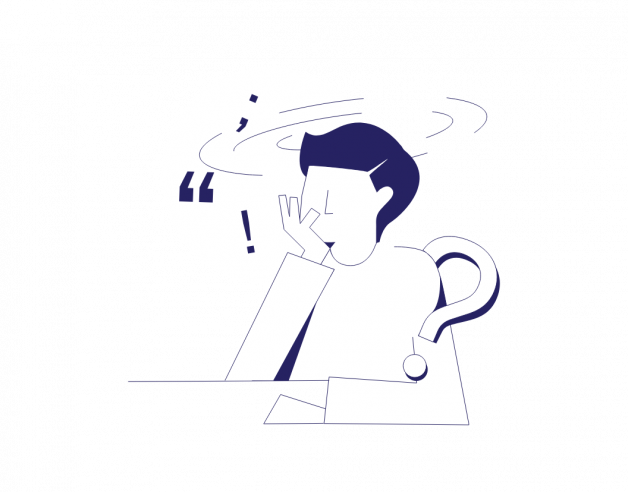
-
5-minute read
-
15th February 2023
Punctuation Tips: Ellipsis
An ellipsis is a set of three periods (aka “dot, dot, dot”). It has a variety of uses in English writing. It can indicate that information has been omitted or is incomplete. It can also mean hesitation (usually in dialogue) or a thought trailing off (usually in dialogue or narration).
While they may seem unimportant or forgettable, ellipses (the plural of ellipsis) are powerful symbols. In this post, we’ll focus on how to use them in your writing.
Using Ellipses to Replace Omitted Text
For formal and academic writing, ellipses are most commonly used to indicate that words or text are missing. If part of a text is missing and you don’t have access to the original source, you can use an ellipsis to show that.
Similarly, you can use an ellipsis if you include a quotation from someone else’s work and cut out a portion of the material (to save space or remove irrelevant information). Take this quote from J.K. Rowling’s Harry Potter and the Sorcerer’s Stone:
Original:
With an ellipsis:
Placing the ellipsis in brackets indicates that it refers to omitted information and is not part of the original text.
Common Mistakes When Using Ellipses With Omitted Text
Make sure that the information you cut truly is unnecessary for your context, that the text still makes sense without that information, and that the meaning of the writing isn’t changed by your omission. For example, using the above quote, note what happens when the ellipsis is placed in a different part of the sentence:
Now, we’ve changed the meaning from the author’s intended one. We’ve also removed important information that’s needed to understand the quote and its context (i.e., whose hand the Remembrall was snatched from).
Another important thing to remember is that you can use an ellipsis only if the words around it form a grammatically correct sentence. This task involves carefully choosing what words will be cut. Let’s look at our example:
This is now a sentence fragment. The words immediately before and after the ellipsis could technically go together, but it’s important to read the sentence as a whole to make sure it’s complete.
Using an Ellipsis to Create a Pause
Ellipses are often used in dialogue to imitate the way people actually speak – in incomplete sentences with random pauses and trailing thoughts. Looking at another quote from Harry Potter and the Sorcerer’s Stone, we can see how ellipses mimic real human speech:
Find this useful?
Subscribe to our newsletter and get writing tips from our editors straight to your inbox.
Subscribe to Beyond the Margins and get your monthly fix of editorial strategy, workflow tips, and real-world examples from content leaders.
Thanks to ellipses, we can imagine the character’s tone and expressions as the character is speaking, making the dialogue more believable.
Ellipses are also useful to indicate a pause for dramatic effect or to suggest that something more is coming. For example:
The town is safe again. For now…”
Common Mistakes With Ellipses and Trailing Thoughts
While ellipses are powerful tools for storytelling, they should be used sparingly. Try to avoid using too many in one passage, and don’t use them in every piece of dialogue.
In addition, be careful not to end every section of text with a suspenseful pause. Those dramatic pauses will lose their impact if the reader comes to expect them. Also, don’t use an ellipsis if doing so would make the thought or sentence complete. If it makes sense to use a period, a comma, or a semicolon, you should never use an ellipsis in place of these marks.
Punctuation and Spacing With Ellipses
When an ellipsis is used at the end of a sentence, you should add a period after the last dot. This practice can differ between style guides, though, so make sure you check your style guide to see if it has any specific requirements for using ellipses.
When an ellipsis is used in the middle of a sentence, the punctuation around it shouldn’t be altered, but you do need to add a space after the ellipsis. And if you use an ellipsis at the beginning of a sentence, you should add a space after it and capitalize the first letter of the first word.
In Microsoft Word and most other word processing systems, you can create an ellipsis by pressing ALT while typing 0133.
Summary
Ellipses are useful tools for writers, and they can be used in a variety of ways. Let’s sum up the main things to remember so that you can use ellipses effectively. We hope this post helps you use ellipses correctly in your writing. If you want an extra set of eyes to check your work, though, be sure to send it our way! Our experts will check your writing for issues with punctuation, spelling, grammar, and more. Try out our service for free!
FAQs
What is an ellipsis, and how is it used in writing?
An ellipsis is a set of three dots (or periods). It can indicate missing or omitted text, create a pause to add suspense, or show that a thought has trailed off.
When should an ellipsis be used in a quotation?
If your quote is missing text or you want to omit an unnecessary section of the quote, you can replace the cut portion with an ellipsis. You should place the ellipsis in square brackets and make sure that the text around it makes sense and flows correctly.